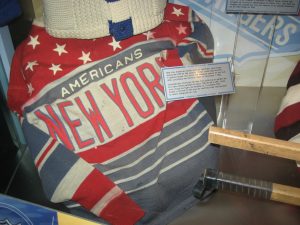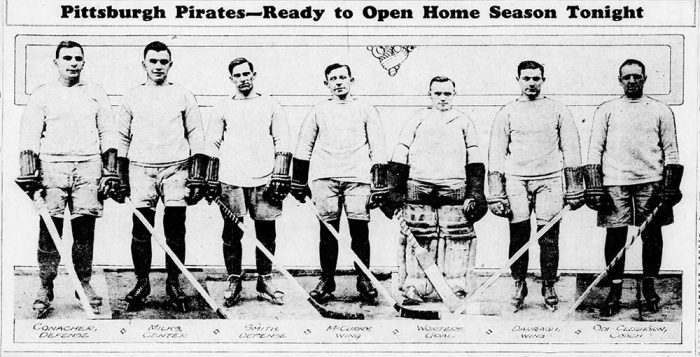This Day in Hockey History – December 2, 1925 – Pirates Come Home but Americans’ First
(Photo: The Pittsburgh Post Gazette)
A year and a day after the Boston Bruins and Montreal Maroons played their first game, on December 2, 1925, the New York Americans played their first as a franchise. The Amerks scored their first two goals and earned their first win, while their opponents, the Pittsburgh Pirates, played their first home game and experienced their first loss.
Bootlegger William Dwyer had a role in the beginnings of the two newest NHL franchises, New York and Pittsburgh. First, he paid out Tom Duggan (owner of Mount Royal Arena in Montreal) for the New York option, which was approved on April 17, 1925. Then, he partnered with attorney James F. Callahan, who had purchased the Pittsburgh Yellow Jackets of the U.S. Amateur Hockey Association. The Pittsburgh franchise was approved November 7, 1925.
Both cities had had rinks and amateur hockey clubs since the 1890s, but as of 1925, they would have professional NHL teams. The new team names were nods to their local professional baseball teams, the New York Yankees and the Pittsburgh Pirates. The Americans were able to stock their squad with players who had been suspended from the Hamilton Tigers (for striking), and the Tigers left the NHL in September. Meanwhile, the Pirates were able to keep many players from the Yellow Jackets and even decked them out in the same colors of black and gold.
The Pirates began their debut season on the road. They won their first game 2-1 and then won their second after Georges Vezina played his final 20 minutes in the NHL. As the Pittsburgh Post-Gazette rightly gloated, “Fresh from brilliant and unexpected triumphs in the hostile domains of the Boston Bruins and Canadiens of Montreal, the mighty Steel City sextet returns to historic Duquesne Garden to stage a home debut and to offer Pittsburgh fans their initial taste of modern professional hockey.” The day before the game, the Americans arrived in Pittsburgh and stayed in a hotel very close to the arena. “A day of rest left the sticksters primed for a stiff workout at the Garden last evening,” noted the Post-Gazette.

By Nhl4hamilton | Chit-Chat [Public domain],
from Wikimedia Commons
The Pirates fared better than the Americans that season. With 39 points (19-16-1) they finished third of seven teams, just good enough to make the playoffs. The Americans earned 28 points (12-20-4) to finish fifth.
Neither team made it to the Original Six era. The Pirates played through the 1929-30 season only making the playoffs once more. They tried moving to Philadelphia (to play as the Quakers), but their truly terrible record (4-36-4) made the 1930-31 season their only one. They officially folded in 1936, but both Pennsylvania cities got teams in the 1967 expansion.
As for the Americans, they had to face competition from the New York Rangers, who began playing at their rink, Madison Square Gardens, in 1926. Unlike the Rangers, the Amerks usually placed fourth or fifth and only made it to the playoffs five times during their 18 seasons. The competition for ticket sales and the loss of Dwyer’s revenue after Prohibition ended led Dwyer to attempt to sell the team in 1935-36. When he couldn’t find a buyer, he abandoned the team, and the NHL took control. Although Red Dutton eventually took the reigns, he couldn’t manage the debt and had to sell most of their top players as WWII began. He tried changing the name to the Brooklyn Americans with the intention to move there but had to suspend operations instead. When he was ready to build a rink in Brooklyn after the war in 1946, the NHL chose not to let the Americans back in the league. The teams that had begun together in 1925 officially were made defunct ten years apart, in 1936 and 1946.
Additional Sources:
- Stephen Laroche, Changing the Game: A History of NHL Expansion (Toronto: ECW Press, 2014), 23-34.
- “Pro Hockey Season Opens At Garden Tonight,” Pittsburgh Post-Gazette, 2 Dec. 1925, p. 13-14.
- Chester L. Smith, “Pirate Sextet Beaten by New York, 2-1,” Pittsburgh Post-Gazette, 3 Dec. 1925, p. 13-14.














